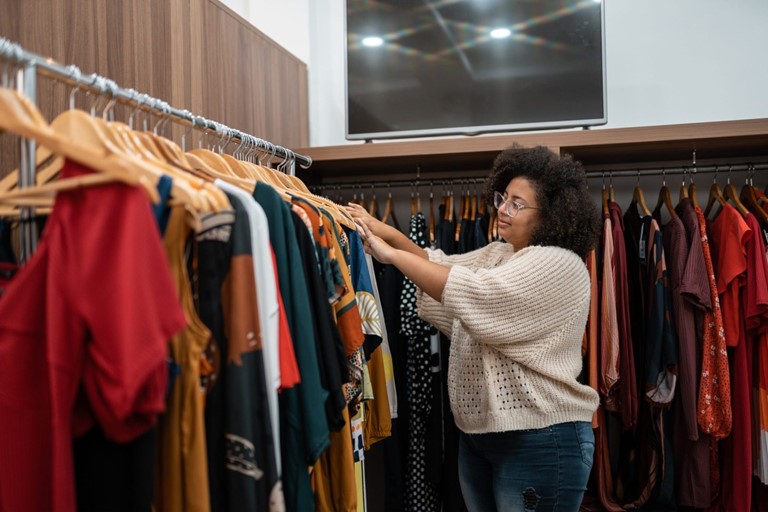
对Ozempic和Wegovy减肥药用户来说,减肥成了疯狂购物的理由,奢侈品经销商也在密切关注。二手奢侈品时尚市场发现人们在减肥过程中会更新衣柜,而减肥药物日益普及可能加快趋势。
据《Vogue Business》报道,二手时尚平台Poshmark称过去两年中大码服装上架数量增加了103%,其中3XL增加103%,4XL增加80%,5XL增加73%。Poshmark还指出,在具体描述或标题中提到“减肥”的新商品增加了78%。
“随着减肥新药不断出现,我们预计Poshmark将协助客户踏入新生活方式,”Poshmark联合创始人兼商品副总裁特雷西·孙告诉《Vogue Business》,“我们发现供需变化,密切关注趋势,从而为客户提供贴心服务。”
除了美国人逐渐抛弃大码衣服,服用GLP-1减肥药的人们买新衣服同样推动了趋势。设计师服装租赁平台Rent the Runway联合创始人兼首席执行官珍妮弗·海曼留意到,与过去15年相比,越来越多消费者购买衣服的尺码变小。Lafayette和Amarra等高端时尚和奢侈品牌也发现了这一趋势。
市场研究公司凯度(Kantar)咨询部门副总裁利·奥唐纳告诉《财富》杂志,购物趋势变化很有可能与越来越多消费者使用减肥药有关。减肥的人们可能会很快更换不同尺寸的衣服,他们会去二手市场处理而不是买新衣服。奥唐纳表示,如果想处理不再合身的旧衣服,通过转售平台能获得积分,进一步激励用户在平台上购买。
不过对于第一次达到目标体重的人来说,购物还有额外的吸引力,就是进一步凸显个人风格。Ozempic减肥用户在杂货和家居用品方面购物习惯改变,倾向营养更丰富或质量更好的商品,对衣柜的调整可能也一样。
“尤其是努力重塑自己时,可能不再会选可穿可不穿的衣服,”奥唐纳说。
Ozempic如何改变消费品
约八分之一美国人尝试过Ozempic或Wegovy等GLP-1抑制剂控制体重,随着人们体型和所需衣物尺寸变化,时尚界受到刺激也就顺理成章。美国人口普查局(U.S. Census Bureau)的数据显示,由于消费者信心疲软,时尚行业表现不佳,截至5月服装和配饰销售额同比下降0.9%。
Ozempic减肥药引发的影响对二手奢侈品行业的利好作用可能更明显,正是二手奢侈品行业扭转了时尚行业下滑的趋势。由于热衷昂贵产品的消费者受通胀影响,努力寻找价廉物美的平替,高端商品转卖的增速已是一手奢侈品市场的两倍。管理咨询公司贝恩(Bain & Co.)的数据显示,2023年奢侈品转售市场达到490亿美元,预计今年增速为1%至4%。
其他行业已抓住机会,吸引了不断增长的Ozempic减肥用户群体。雀巢专门为GLP-1减肥用户推出了一系列小份冷冻食品。慧俪轻体(WeightWatchers)则计划提供Wegovy等减肥药。
但大规模变化也存在风险,因为很大程度上来说相关药物的长期影响仍然未知,很多人停止服药后体重会反弹。虽然现在Ozempic成了热潮,对消费品的持久影响还很难说。
尽管时尚市场努力跟上时代发展,仍然存在风险。奥唐纳说,服用减肥药的人可能更愿意买新衣服,但在达到理想体重之前不一定会大手笔买奢侈品。
“几乎所有跟我谈过GLP-1的人都说,‘我想买衣服,但现在还没减到位,所以会忍住,’”她说。
问题不仅仅在二手市场方面。人工智能预测公司Impact Analytics的创始人兼首席执行官普拉尚特·阿格拉瓦指出,随着服装尺寸缩小,服装生产商在适应方面可能越来越痛苦。该公司发现,随着更多人服用减肥药,零售商也在调整尺码模型适应更纤细的身材。
尺寸曲线,或者叫零售商为消费者提供的一系列尺寸,在库存备货时一直有碰运气的成分。消费者倾向更小号衣服后,确定尺码曲线愈加困难。一旦曲线出错,服装公司每年因库存过剩和资源浪费损失可能高达2000万美元。
阿格拉瓦在一份声明中表示:“零售商要密切关注动向,这是可持续性问题。可不能做出一堆商品最后没人要。”(财富中文网)
译者:梁宇
审校:夏林
对Ozempic和Wegovy减肥药用户来说,减肥成了疯狂购物的理由,奢侈品经销商也在密切关注。二手奢侈品时尚市场发现人们在减肥过程中会更新衣柜,而减肥药物日益普及可能加快趋势。
据《Vogue Business》报道,二手时尚平台Poshmark称过去两年中大码服装上架数量增加了103%,其中3XL增加103%,4XL增加80%,5XL增加73%。Poshmark还指出,在具体描述或标题中提到“减肥”的新商品增加了78%。
“随着减肥新药不断出现,我们预计Poshmark将协助客户踏入新生活方式,”Poshmark联合创始人兼商品副总裁特雷西·孙告诉《Vogue Business》,“我们发现供需变化,密切关注趋势,从而为客户提供贴心服务。”
除了美国人逐渐抛弃大码衣服,服用GLP-1减肥药的人们买新衣服同样推动了趋势。设计师服装租赁平台Rent the Runway联合创始人兼首席执行官珍妮弗·海曼留意到,与过去15年相比,越来越多消费者购买衣服的尺码变小。Lafayette和Amarra等高端时尚和奢侈品牌也发现了这一趋势。
市场研究公司凯度(Kantar)咨询部门副总裁利·奥唐纳告诉《财富》杂志,购物趋势变化很有可能与越来越多消费者使用减肥药有关。减肥的人们可能会很快更换不同尺寸的衣服,他们会去二手市场处理而不是买新衣服。奥唐纳表示,如果想处理不再合身的旧衣服,通过转售平台能获得积分,进一步激励用户在平台上购买。
不过对于第一次达到目标体重的人来说,购物还有额外的吸引力,就是进一步凸显个人风格。Ozempic减肥用户在杂货和家居用品方面购物习惯改变,倾向营养更丰富或质量更好的商品,对衣柜的调整可能也一样。
“尤其是努力重塑自己时,可能不再会选可穿可不穿的衣服,”奥唐纳说。
Ozempic如何改变消费品
约八分之一美国人尝试过Ozempic或Wegovy等GLP-1抑制剂控制体重,随着人们体型和所需衣物尺寸变化,时尚界受到刺激也就顺理成章。美国人口普查局(U.S. Census Bureau)的数据显示,由于消费者信心疲软,时尚行业表现不佳,截至5月服装和配饰销售额同比下降0.9%。
Ozempic减肥药引发的影响对二手奢侈品行业的利好作用可能更明显,正是二手奢侈品行业扭转了时尚行业下滑的趋势。由于热衷昂贵产品的消费者受通胀影响,努力寻找价廉物美的平替,高端商品转卖的增速已是一手奢侈品市场的两倍。管理咨询公司贝恩(Bain & Co.)的数据显示,2023年奢侈品转售市场达到490亿美元,预计今年增速为1%至4%。
其他行业已抓住机会,吸引了不断增长的Ozempic减肥用户群体。雀巢专门为GLP-1减肥用户推出了一系列小份冷冻食品。慧俪轻体(WeightWatchers)则计划提供Wegovy等减肥药。
但大规模变化也存在风险,因为很大程度上来说相关药物的长期影响仍然未知,很多人停止服药后体重会反弹。虽然现在Ozempic成了热潮,对消费品的持久影响还很难说。
尽管时尚市场努力跟上时代发展,仍然存在风险。奥唐纳说,服用减肥药的人可能更愿意买新衣服,但在达到理想体重之前不一定会大手笔买奢侈品。
“几乎所有跟我谈过GLP-1的人都说,‘我想买衣服,但现在还没减到位,所以会忍住,’”她说。
问题不仅仅在二手市场方面。人工智能预测公司Impact Analytics的创始人兼首席执行官普拉尚特·阿格拉瓦指出,随着服装尺寸缩小,服装生产商在适应方面可能越来越痛苦。该公司发现,随着更多人服用减肥药,零售商也在调整尺码模型适应更纤细的身材。
尺寸曲线,或者叫零售商为消费者提供的一系列尺寸,在库存备货时一直有碰运气的成分。消费者倾向更小号衣服后,确定尺码曲线愈加困难。一旦曲线出错,服装公司每年因库存过剩和资源浪费损失可能高达2000万美元。
阿格拉瓦在一份声明中表示:“零售商要密切关注动向,这是可持续性问题。可不能做出一堆商品最后没人要。”(财富中文网)
译者:梁宇
审校:夏林
Ozempic and Wegovy users are turning their weight loss into a reason for a shopping spree, and luxury resellers are watching. Secondhand luxury fashion markets are noticing people on weight-loss journeys shedding old wardrobes, noting that the rising popularity of obesity medicines could be driving the trend.
Secondhand fashion platform Poshmark revealed a 103% increase in plus-size clothing listings, including a 103% increase in 3XL, 80% in 4XL, and 73% in 5XL listings over the past two years, Vogue Business reported. Poshmark also noted a 78% increase in new items with the term “weight loss” in a description or listing title.
“With the rise of these new medications, we expect that Poshmark will support our customers through yet another life change,” Poshmark cofounder and vice president of merchandising Tracy Sun told Vogue Business. “We’re noticing shifts in supply and demand, and we monitor these trends closely to stay attuned to the customer.”
Combined with Americans getting rid of plus-size clothes is GLP-1 med users’ hunt for a new wardrobe. Jennifer Hyman, cofounder and CEO of designer apparel rental platform Rent the Runway, noticed that more of its consumers are purchasing smaller sizes than they have in the past 15 years. High-end fashion and luxury brands like Lafayette and Amarra are also aware of the trend.
There’s good reason these buying patterns could be associated with a growing base of consumers using weight-loss drugs, Leigh O’Donnell, market research firm Kantar’s consulting division vice president, told Fortune. Those in the process of losing weight may be cycling through different sizes of clothing, leading them to secondhand markets as opposed to buying new clothes. If you’re someone who’s getting rid of old clothes that no longer fit, you may accrue points through resale platforms, which incentivizes you to buy on those platforms, O’Donnell argued.
But for those who are reaching their target weight for the first time, there’s an added appeal to shopping: the prospect of developing a zhuzhed-up personal style. As Ozempic users change shopping habits for groceries and household goods, leaning toward items with denser nutrients or greater quality, they may have the same philosophy regarding their wardrobe.
“Especially if you’re reinventing yourself, you maybe don’t want to go for throwaway clothing,” O’Donnell said.
How Ozempic is shaking up consumer products
With about one in eight Americans having tried Ozempic or another GLP-1 inhibitor like Wegovy, it’s no surprise that the changes in body shapes and sizes would spur action from the fashion world. The industry has struggled amid weak consumer confidence, and as of May, apparel and accessory sales fell 0.9% year over year, according to data from the U.S. Census Bureau.
The Ozempic shake-up could be even better news for the secondhand luxury industry, which has bucked the downward trend of the fashion sector. High-end resale has already grown twice as fast as the primary luxury market as inflation-struck consumers with expensive tastes look for affordable alternatives to their favorite brands. The luxury resale market reached $49 billion in 2023, according to management consultancy Bain & Co., and it’s expected to grow 1% to 4% this year.
Other industries have already jumped at the opportunity to appeal to the growing consumer base of Ozempic users. Nestlé rolled out a line of smaller-portioned frozen meals specifically for users of GLP-1 meds. WeightWatchers launched a plan offering weight-loss drugs like Wegovy.
But there’s a risk for these large-scale changes, as the long-term impact of these drugs is largely unknown, with many users regaining weight after they stop taking the drugs. While Ozempic may be a craze now, its lasting impact on consumer products remains difficult to determine.
There are risks involved for the fashion market trying to keep up with the times. While those on weight-loss drugs may be looking for new clothes, they may not be ready to take the luxury plunge until they reach their desired weight, O’Donnell said.
“Almost everybody that I’ve spoken to qualitatively with GLP-1 says, ‘I’m coming along, but I’m not quite there yet, so I’m going to hold back,’” she said.
This isn’t just a problem for secondhand markets. As clothing sizes shrink, clothing producers may experience growing pains trying to adapt, noted Prashant Agrawal, founder and CEO of AI-based forecasting firm Impact Analytics. The firm found that as more people use weight-loss drugs, retailers are compensating by changing sizing models to accommodate smaller frames.
Sizing curves, or the array of sizes retailers provide for consumers, has always been a hit-or-miss model for stocking inventory. By introducing the variable of shoppers looking for smaller clothes, it becomes even harder to determine those sizing curves. Get those curves wrong and clothing companies could lose $20 million a year in unused inventory and wasted resources.
“It’s something that retailers need to monitor,” Agrawal said in a statement. “It’s a sustainability issue. We can’t make things that won’t get used.”






